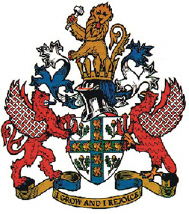
Crawley Council
Crawley Urban District Council was established in 1956 and was divided into eight wards. Crawley Development Corporation sold a site in the Boulevard to the council in 1958 for the town hall, which was opened in 1964. In 1974 the council became Crawley Borough Council.
Coat of Arms

The Coat of Arms was granted on the 8th February 1957, and was presented by the Rt. Hon. Lord Silkin, P.C., at a meeting of the Council on the 21st September 1957. The following explanation is taken from an official council guide book of 1962:
Shield: The cross signifies the importance of Crawley's situation at the junction of the London-Brighton road and the Horsham-East Grinstead road. The nine flying martlets are from the traditional arms of the South Saxons and are appropriately incorporated in many civic arms in Sussex. Their gold colour upon the blue background gives the Sussex colours, and their number suggests the nine Sussex communities which constitute the new town of Crawley. The acorns commemorate the oak forests which covered so much of this area in early times, and are also symbols of steady, strong growth.
Crest: The shield is surmounted by the closed helm and oak leaves which are proper to all civic arms, being in the main colours of the arms, blue and white. The crest upon the helm displays a palisaded crown which relates to the crest of the Crawley Development Corporation and is an emblem of a planned area. The royal lion upon it, brandishing a hammer, symbolises the industrial estate of Manor Royal.
Motto: "I grow and I rejoice." This is a translation of a phrase from Seneca's Epistulae and refers to the establishment of a happy, expanding community.

After Crawley had become a borough, a new coat of arms, incorporating the old UDC insignia, was granted on 2nd April 1976. It was presented to the council on 24th March 24 1977 by Alderman Robert May. The council's website gives the follwoing explanation:
The shield: The cross signifies the importance of Crawley's position at the junction of the London to Brighton and Horsham to East Grinstead roads. The nine flying martlets are from the traditional arms of the South Saxons, and feature in many civic arms in Sussex. Their gold colour on the blue background gives the Sussex colours, and their number suggests the nine communities which made up the original Crawley New Town. The acorns commemorate the oak forests which once covered so much of North Sussex, and also symbolise strong steady growth.
The crest: The shield is surmounted by the closed helm and oak leaves which are proper in all civic arms, and they are blue and white, the main colours of the arms. The crest on the helm features a palisaded crown which relates to the Crawley Development Corporation's crest and is an emblem of a planned area. The royal lion upon it, brandishing a hammer, symbolises Manor Royal industrial estate.
The supporters: The borough of Crawley includes Gatwick, one of the world's largest airports, so the supporters are an eagle on the right of the shield, with its wings raised, and, because Gatwick is a British airport, a winged lion on the left. The silver fretty - the criss-crossed area within the wings - represents Crawley industry, with the silver colour suggesting the steel and aluminium it uses. The two red thunderbolts, held by the lion and the eagle, represent the town's flourishing electrical industry.
The motto: I Grow and I Rejoice is a translation of a phrase from Seneca's Epistulae and refers to the building of a happy, expanding community.
Crawley Council Elections